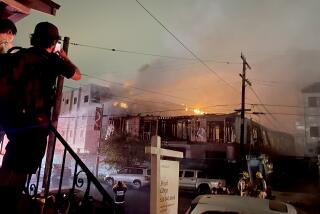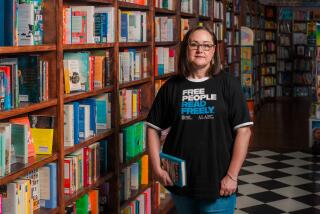Central Library fire: A lot of us are to blame, but it’s time to turn the page
There is no point now in finding a scapegoat for the downtown library disaster. Even if we catch the person who set the fire, we can’t blame him alone.
Many people may be to blame--various mayors, the City Council, the preservationists, and, ironically, even the city librarian himself.
But ultimately the blame must fall on us--the citizens of Los Angeles.
We have been reluctant to pay for our library; we have rejected bond issues and voted for Proposition 13. One of the reasons for the council’s fateful temporizing was public apathy.
Some have blamed preservationists, complaining that in their zeal to save the old library they blocked its replacement with something modern.
I myself am among the sentimentalists who hoped that the old building could be saved as an architectural landmark, giving texture and perspective to the stark new downtown skyline.
But I had known for years that it was unfit to work in and to house its enormous and precious collection. As John D. Weaver proposed in The Times years ago, I believed that the city needed not so much a new building as a modern library system, to bring it into the 20th Century, if not the 21st. The building could be kept as an administrative center, with perhaps a small collection for downtown borrowers.
For more than 30 years the Fire Department had been warning that the building was a firetrap: A disastrous fire could come any day. And yet the City Council dawdled.
In 1972 I wrote an article on the library for Westways magazine, pointing out its hazardous obsolescence:
“Its troubles are many. It isn’t big enough anymore, not by about four-fifths. It is a dreadful place to work in. It is physically obsolete. . . . The fire hazard (is) great. . . . “
At that time, 14 years ago, I looked into the notorious stacks, which fire inspectors had described as a chimney:
“It was like stepping into some gothic prison. It was hot and airless. There was no air conditioning and few fans. The old electrical circuits were loaded to their limits. It was dim. The long, narrow corridors between the stacks of books were lighted only by an occasional hanging naked bulb of 40 watts. . . .
“Life in the stacks, I was told, was grim. As I could see, lanes were narrow. Head clearance was low. Exits were cluttered. People working in the darker corners needed flashlights. The only ventilating system brought in unwashed downtown air from the streets through vents in the floor. The building’s thick walls provided a merciless insulation, turning the stacks in hot weather into an oven. . . . “
I talked to City Librarian Wyman Jones in his office. His vision was catastrophic. “Look around you,” he told me. “You don’t see any coffee pots like they have in other buildings. The circuits couldn’t stand it. If somebody gave me an air-conditioning system for this office, I couldn’t plug it in without blowing out a circuit.
“Eighty-five percent of our collection is in the stacks, behind the scenes. You can’t browse. The books are out of reach. We have a small army of people working around the clock, carrying books in and out.
“The stacks are like an open flue. All we can do, they tell us, in case of fire is get people out and stand back. . . . “
That, of course, is exactly what happened.
Jones was not moved by the old library’s Byzantine-Egyptian splendor. “I’m not indifferent to some of the values of this building,” he said. “ But we’ve got thousands of books on architecture in this library, with thousands of pictures of outstanding buildings, and you can’t find a picture of this building in any of them.
“It may be a landmark to a lot of people, a symbol of a Los Angeles that is no more. But a good piece of architecture, to me it isn’t. I have no nostalgia here, no sense of history. All I know is that the building doesn’t do the job by 10 country miles.”
Jones favored a new building over modernization. The preservationists wanted to keep the old one; immobilized between the two, the city at long last put together a financially feasible compromise for remodeling the old building, adding a wing and erecting a commercial tower to pay for it. Ironically, the work was to begin next year.
But in the end it was we, the people, who let the library down.
As Wallace Stegner said at a library dedication in Arizona:
“These are the occasions on which we are more or less expected to say the expected; to congratulate one another on the value of shared and cherished learning; to assert the durability of the highest human traditions in the face of ignorance, barbarism and obscurantism; to celebrate the triumph of light over darkness. We tend to ignore the fact that only a small percentage of Americans cares at all about libraries or what they provide. . . . “
Los Angeles has been called the city of the future. In this event, it was caught sleeping in its past.
But in the end, the city was brought together by the disaster, not divided. There has been very little finger-pointing. Firefighters risked their lives to save the collection. Electricians waded in water to restore power. Not only librarians, but also civilians by the hundreds came forth to help remove the damaged books. Arco made room in its nearby tower for the library staff. The J. Paul Getty Trust gave $2 million.
Perhaps we will rise above it.
More to Read
Sign up for Essential California
The most important California stories and recommendations in your inbox every morning.
You may occasionally receive promotional content from the Los Angeles Times.










